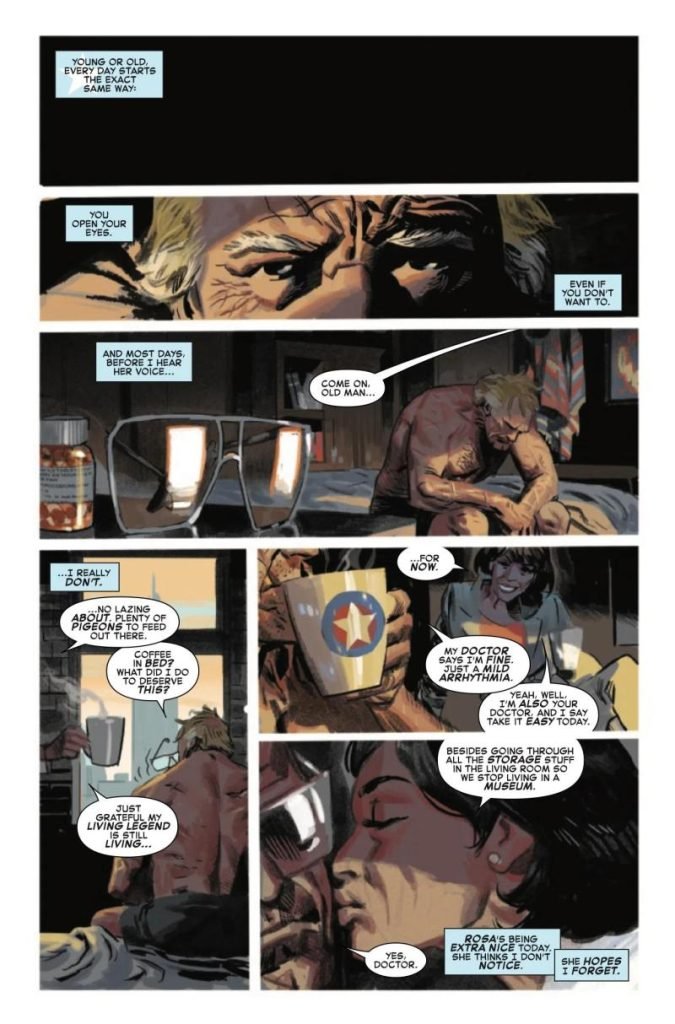Writer: Chip Zdarsky
Artist: Daniel Acuna
Marvel Comics, January 2024

Stop us if you have heard this one before.
A thrillingly dark new vision of the Avengers! In a gleaming new world of prosperity, Captain America is no more. But Steve Rogers still exists, floating through an America where freedom is an illusion, the Avengers are strangers and his friends are long dead. But is the Dream itself dead? And how do you assemble Avengers in a world that doesn’t want them? With the clock ticking down to New Year’s Day, Steve must build an army to save America! Will his surviving friends sign up, or will he have to lead the ragtag group called the Defenders against the expert military marksman known as Bullseye? And can Steve infiltrate the Raft, a government facility full of secrets and danger off the shores of New York City, before the new Iron Man sentences him to the same gruesome fate as Tony Stark?
That is the marketing copy for Avengers: Twilight, a limited series published by Marvel Comics, written by Chip Zdarsky and with art by Danuel Acuna, and focussing on Marvel’s iconic character Captain America.

In circumstances where the comic book publisher (unlike the larger affiliated company Marvel Studios) cannot bring itself to permanently conclude the adventures of any of its even insignificant characters, creative teams are egged on to consider various grim futures for the Avengers and other superheroes in the stable. Marvel Comics has a long history of crystal ball gazing for its characters’ destinies, going back to The Uncanny X-Men story Days of Future Past (1981). We have otherwise seen this with:
a. Old Man Logan (2008) (Captain America is beheaded by the Red Skull in a battle which destroys Washington DC, the Fantastic Four have disappeared, Thor is killed by Magneto and the Absorbing-Man, the Hulk is transformed into a hillbilly ruler of inbred green children, the Punisher dies after a fight with copycats, and Spider-Man’s daughter is a bad guy);
b. Thanos Wins (2018) (Captain America and the Red Skull have been fed to the Hulk, Thor dies in battle against Thanos, the Punisher sold his soul to the devil Mephisto);
c. back in 1999, Earth X (a magic spell has made Thor female, Captain America has killed the Red Skull, the Hulk is split into two people, Absorbing Man fused with Ultron and has killed most of the Avengers, Daredevil is an actual devil).
In Avengers: Twilight, Captain America is robbed of his powers but reacquires them, Daredevil is quietly murdered by America’s ruling regime because of his efforts in court to defend the unjustly accused (Daredevil is a lawyer), Ultron and Hulk have destroyed the city of Boston and killed Spider-Man, and what seems to be the top half of Iron Man is pickled in a glass tube by his evil son, James.

Marvel Comics have doubled down on the series, commissioning the very expensive artist Alex Ross for cover art. But Avengers: Twilight is yet just another peek at an indeterminate future. Each of these series, published over many decades, is akin to watching a Rubik’s Cube being jumbled, whereby the iterations are always different but the colours are the same. It is tiresome.
The only redeeming feature of Avengers:Twilight is the focus on a techno-fascist state resembling a cross between modern China and Judge Dredd’s MegaCity One. There is a scene where Captain America is being savagely beaten by armoured enforcers called Iron Cops which remarkably resembles a panel in Batman: Judge Dredd – Judgment on Gotham (1991). Dredd’s eagle sits on his chest and the Iron Cops’ eagle is a patch on their shoulders, but otherwise both have helmets covering most of their faces (for the Iron Cops, an iteration of Iron Man’s helmet) and are very happy using nightsticks on “perps”. Otherwise, surveillance is everywhere and people are prohibited from creating images (including selfies). We assume this is to ensure that evidence of any truth is controlled by the state. It is a disturbing backdrop for the story because it is completely believable.
We have not previously encountered Daniel Acuna’s art. It is sort of crayon-y. This is no criticism at all, as it has texture and depth especially in darkened landscapes, and pops in action scenes with the mania of Bill Sienkiewicz. It is a shame Mr Acuna’s talents were wasted on the House of Idea’s latest rehash.


